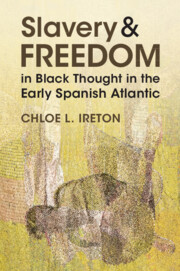Figures
1.1Abraham Ortelius, “Regni Hispaniae post omnium editiones locumplessima Descriptio” (detail of “Guadalquivir River [printed in illustration as Guadalquivir Rio] to Sevilla”). In Hispaniae illustratæ seu Rerum vrbiumq. Hispaniæ, Lusitaniæ, Æthiopiæ et Indiæ scriptores varii. Partim editi nunc primum, partim aucti atque emendati. Francofurti: Apud Claudium Marnium, & Hæredes Iohannis Aubrij, 1603. John Carter Brown Map Collection, b22212917. Courtesy of the John Carter Brown Library.
1.2Map of shipping routes in the sixteenth-century Spanish and Portuguese Atlantic world, principally depicting the Spanish crown’s Carrera de Indias routes, including the Flota de la Nueva España and the Flota de Tierra Firme, as well as broadly representing the principal shipping routes of European ships that forcibly displaced enslaved people from West Africa and West-Central Africa to Spanish and Portuguese Americas and Europe (often described as the “Middle Passage”). Map drawn by Cath D’Alton, Drawing Office, University College London.
2.1Photograph of the present-day facade of the palace in Sevilla where Felipa de la Cruz was enslaved; known in the late sixteenth century as Casa-Palacio Fernández de Santillán, and presently known as Palacio del Marqués de la Motilla. Photograph by Miguel Ángel Rosales, 2024. Reproduced with permission from Miguel Ángel Rosales.
2.2Location of the palace where Felipa de la Cruz was enslaved and an approximate outline of the parish where she resided (San Salvador), overlaid on Tomás López de Vargas Machuca, “Plano geométrico de la ciudad de Sevilla….” Tomás López: Madrid, 1788. David Rumsey Map Collection, List no. 10717.000, David Rumsey Map Center, Stanford Libraries. Adaptation of the map by Cath D’Alton, Drawing Office, University College London.
2.3Map of a fifteen-minute walk from Felipa de la Cruz’s dwelling to the House of Trade, overlaid onto Tomás López de Vargas Machuca, “Plano geométrico de la ciudad de Sevilla….” (detail). Tomás López: Madrid, 1788. David Rumsey Map Collection, List no. 10717.000, David Rumsey Map Center, Stanford Libraries. Adaptation of the map by Cath D’Alton, Drawing Office, University College London.
2.4Alonso Sánchez de Coello, “Vista de la ciudad de Sevilla,” late sixteenth century, oil on canvas, width: 295 cm, height: 146 cm (P004779). Prado Museum, Madrid. © Photographic Archive Museo Nacional del Prado.
2.5Alonso Sánchez de Coello, “Vista de la ciudad de Sevilla,” (detail), late sixteenth century, oil on canvas, width: 295 cm, height: 146 cm (P004779). Prado Museum, Madrid. © Photographic Archive Museo Nacional del Prado.
2.6Alonso Sánchez de Coello, “Vista de la ciudad de Sevilla,” (detail), late sixteenth century, oil on canvas, width: 295 cm, height: 146 cm (P004779). Prado Museum, Madrid. © Photographic Archive Museo Nacional del Prado.
3.1Approximate routes along which Margarita de Sossa was forcibly displaced as an enslaved woman and latterly as a free woman. Map drawn by Cath D’Alton, Drawing Office, University College London, based on a map drawn by Alex Killough in Ball et al., As If She Were Free, 31.
3.2Map of two royal trading routes in sixteenth-century New Spain between San Juan de Ulúa and Mexico City, known as Camino de Veracruz and Camino Nuevo. Map drawn by Cath D’Alton, Drawing Office, University College London, based on “Archipelague du Mexique où sont les isles de Cuba, Espagnole [Haïti], Jamaïque, etc. [Document cartographique].” Jean Covens et Corneille Mortier, Amsterdam, 1741. Bibliothèque Nationale de France, FRBNF40739006.
3.3Juan Gómez de Trasmonte, “Forma y Levantado de La Ciudad de México.” A. Ruffoni: Florence, 1628. David Rumsey Map Collection, list no. 13213.000. David Rumsey Map Center, Stanford Libraries.
3.4Juan Gómez de Trasmonte, “Forma y Levantado de La Ciudad de México” (detail). A. Ruffoni: Florence, 1628. David Rumsey Map Collection, list no. 13213.000. David Rumsey Map Center, Stanford Libraries.
4.1Locations of Black and mulato brotherhoods and other sites where Black people gathered and worshiped in late sixteenth-century Sevilla, overlaid onto Tomás López de Vargas Machuca, “Plano geométrico de la ciudad de Sevilla…” (detail). Tomás López: Madrid, 1788. David Rumsey Map Collection, List no. 10717.000, David Rumsey Map Center, Stanford Libraries. Adaptation of the map by Cath D’Alton, Drawing Office, University College London.
4.2“Pleito entre la Hdad de Ntra Sra de la Antigua y la de los Ángeles que llaman la de los morenos con sede en San Roque extramuros” (detail of in-text edits to the declaration that the Black confraternity members made before their procurator, Bartolomé de Celada, on June 22, 1604), in Archivo General del Arzobispado de Sevilla (AGAS), Fondo Arzobispal, Sección III, Hermandades, sign. 09885, expte 1, fols. 14r–v. © Cabildo Catedral de Sevilla.
4.3“Pleito entre la Hdad de Ntra Sra de la Antigua y la de los Ángeles que llaman la de los morenos con sede en San Roque extramuros” (detail of in-text edits to the declaration that the Black confraternity members made before their procurator, Bartolomé de Celada, on June 22, 1604), in AGAS, Fondo Arzobispal, Sección III, Hermandades, sign. 09885, expte 1, fols. 14r–v. © Cabildo Catedral de Sevilla.
4.4Spanish transcription of Figures 4.2 and 4.3. Author’s illustration.
5.1Map of the Southern Atlantic, with lines showing the enslavement and forcible displacements across the Atlantic of Domingo de Gelofe, Pedro de Carmona, and Francisco Martín. Map drawn by Cath D’Alton, Drawing Office, University College London.
C.1.1Map of the social ties of a generation of free and liberated Black Sevillians in the late sixteenth century (c. 1569–1626). Map drawn by Cath D’Alton, Drawing Office, University College London. With thanks to Antonio Collantes de Terán Sánchez and Víctor Pérez de Escolano for granting me permission to redraw a map of Sevilla based on the maps that they each published in the following publications: Víctor de Pérez Escolano and Fernando Villanueva Sandino, eds., Ordenanzas de Sevilla, facsímil de la edición de 1632, impresa en Sevilla por Andrés Grande. Sevilla: OTAISA, 1975; Antonio Collantes de Terán Sánchez, Sevilla en la baja Edad Media: La ciudad y sus hombres. Sevilla: Sección de Publicaciones del Excmo. Ayuntamiento, 1977. Please note that the parish lines in the redrawn map are based on research by Antonio Collantes de Terán Sánchez into parish boundaries in sixteenth-century Sevilla and published in the above-mentioned publication.
